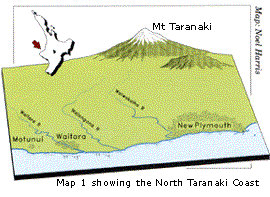Waitangi Tribunal & the Motunui-Waitara claim
The Importance of the Reefs to Te Atiawa

Te Atiawa's fishing reefs stretch for 50 to 55 kilometres along the north Taranaki coast and are some of the largest fishing reefs of any Maori tribe. Te Atiawa's songs and legends speak about the reefs. They are a source of pride and prestige as well as seafood. Each hapu of Te Atiawa is associated with certain reefs, and the hapu only collects seafood from the reefs that belong to it. The people collect kina, paua, koura, and other shellfish, as well as catch fish. It had been like this for many years before the arrival of Europeans in the 1800s.
The Cultural Importance of the Seafood Resource
Kaimoana is a valuable resource. It is also a renewable resource, so long as no man-made or natural disaster occurs.
Seafood has played an important part in the diet and culture of Maori people for centuries. From earliest times, they have followed certain practices so that the resource would be conserved for future generations.
Kaimoana has important cultural as well as economic value to the Te Atiawa people. To provide kaimoana at a hakari for manuhiri is a very important part of tribal mana. As one tribal member said at the Waitangi Tribunal hearing: 'mataitai is very valuable, more valuable than meat – without that our table is nothing'.
Te Atiawa traditionally looked after their reefs in a number of ways:
- they collected seafood rotationally;
- they collected certain types of seafood only in certain seasons;
- they avoided any form of rubbish or human waste near the sea or the streams that run into the sea;
- no fishing was allowed after a death at sea; and
- they avoided gutting fish and shelling shellfish below the high-tide mark.
In the traditional Maori view, water is tapu. This means Maori tend to feel more strongly than other cultures in New Zealand about different types of water being mixed. Water that is polluted by effluent, whether human or industrial waste, should not be mixed with a food source or waters used for washing, bathing, and fishing. Even if the effluent has been treated so it is almost clean enough to drink, it is still regarded as culturally polluted. One tribal member explained it to the Tribunal like this: 'If we eat food that has particles of mortuary waste of possibly people we know – we are presenting a kind of insult.'
Next: The Problem
This page was last updated: